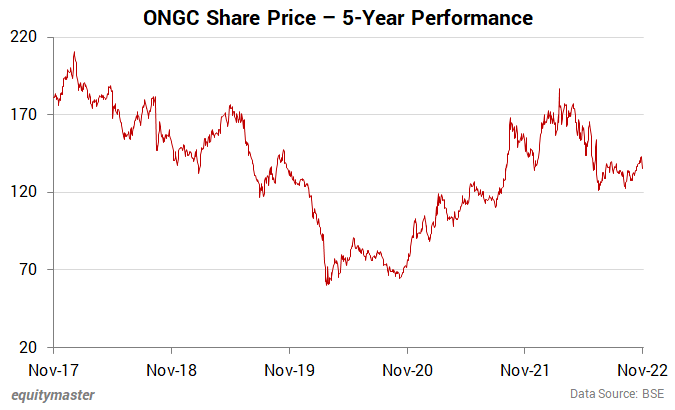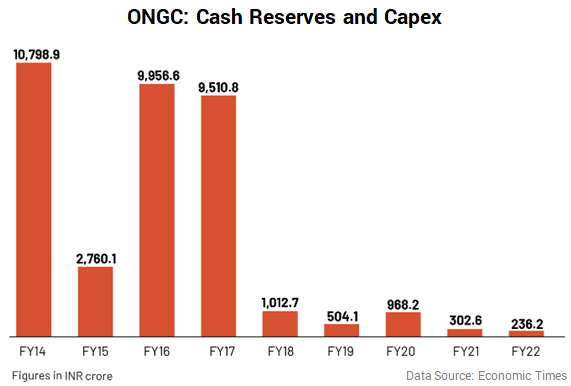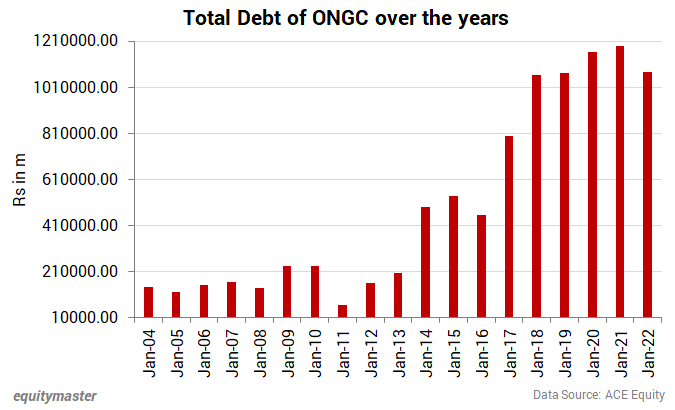- Home
- Views On News
- Nov 23, 2022 - Why ONGC Share Price is Falling
Why ONGC Share Price is Falling

The Ukraine - Russia war was heart-breaking for humanity and its after-effects have left everyone devastated.
However, the scenario is slightly different if we look at the trade side, especially for exporting countries. Russia and Ukraine both are exporting countries. Russia is the world's second largest crude oil exporter.
Hence, an economic disturbance in both these countries generated opportunities for other countries.
For example, due to the shortage of crude oil and gas created by the war, crude oil and gas prices soared through the roof, which was a profit driver for oil refineries over the world.
Hence, one would conclude that ONGC, the largest crude oil and natural gas company in India, would have sailed the winds with great speed.
However, that is not the case. In fact, ONGC's share price and profit have taken a hit during the said period.
Let's understand why...
Poor Quarterly Results
For the quarter that ended 30 September 2022, ONGC reported a total revenue of Rs 1,709.8 billion (bn). This is 7% lower compared to the June 2022 quarter.
The net profit for the same period came in at Rs 72.9 bn, which is 3% lower compared to the previous quarter.
On a YoY basis, the revenue has increased by 39%. However, the profit has reduced sharply despite growing sales. In the same period, ONGC's profits have fallen by 60%.
Why did this happen? Why did profit fall sharply in the quarter that ended on 30 September 2022?
There are two main reasons responsible for the sharp fall in profitability of ONGC. However, both reasons are related to taxes.
Last year in September 2021, ONGC adopted a new tax regime. Under this tax regime, ONGC adopted a new tax regime under which it had to pay a lower tax of 22% resulting in a decrease of Rs 13 bn in taxes and a reduction of Rs 85.4 bn in deferred taxes.
This is why ONGC did exceptionally well and reported high profits in the year ago period.
The other reason is the levy of windfall taxes.
In July this year, the government of India announced a windfall tax that was expected to negatively impact oil and gas companies in the country.
As the name suggests, a windfall tax is a tax levied by the government only in case the industry is earning unjust windfall gains. The tax is only levied in the public interest.
Hence to control the rising domestic oil price and to meet the domestic need for petrol, on 1 July 2022, the government introduced a windfall tax.
The export duty of Rs 6 per litre was levied on auto fuel including petrol and aviation turbine fuel (ATF). A special excise duty of Rs 13 per litre was also levied for the export of diesel.
The government brought in various changes to windfall tax during the rest of the year. Hence owing to windfall taxes, ONGC had to pay additional excise duty of Rs 640 bn.
All of this took an impact on ONGC's share price.
In July this year, ONGC was experiencing similar downtrend in its share price, and we wrote a detailed editorial explaining why. You can check it out here: Why ONGC Share Price is Falling.
How ONGC share price has performed recently
ONGC's share price has been under pressure lately. Windfall taxes and the absence of a regular chairman for a long time have impacted its share price.
On a YoY basis, the share price has been beaten down by 8%.
Even if we take a longer duration, one can see that the share hasn't performed well. In a five-year period, ONGC's share price fell by 25%.

A similar fall can be seen in the cash reserves of the company. The cash reserves of the company have fallen by 48% in the past 5 years.
How did the richest company in India become a debt-laden, cash-dry company?
The fall of ONGC
#1 Depleting cash reserves
ONGC - a Nifty 50 was one of the most profitable and cash-rich companies in India. However, the scenario has changed for the worse.
The cash reserves of the company have been depleting. After 2016-17 the reserves have seen a sharp fall. The company has been pushing out dividends on a large scale.
Between 2014 and 2022, ONGC diverted its profits by way of dividends to the extent of Rs 607.7 bn, which amounted to 45-50% of its profits.

#2 Heavy Acquisitions
In 2016, ONGC acquired gas blocks in the Krishna Godavari (KG) region belonging to Gujarat State Petroleum Corporation (GSPC) for around Rs 80 bn. But even after a whopping investment of around Rs 200 bn, the block hasn't seen much commercial production.
In January 2018, ONGC acquired a 51.1% equity stake in Hindustan Petroleum Corporation (HPCL).
It was an all-cash deal of Rs 369.2 bn, at a price that was 14% higher than the market rate, HPCL's closing share price, on 31 January 2018.
Despite holding a controlling stake in HPCL, it has no managerial control over the company.
#3 Heavy Debt
The most devastating effect of the HPCL deal was that it pushed ONGC into high debt. It borrowed Rs 350 bn to make the deal.
ONGC's debt levels have been increasing on a scary scale.

Investment Takeaway
Just like all PSUs, ONGC is going through operational difficulties. Being a government company that has to earn profits and run in the country's interest is not easy after all.
A government company earns for the government, which uses the money to run a country well. Hence, if the cash reserves of a government company aren't used for the public in a pandemic, then the money is basically sitting idle.
However, ONGC has been working on turning it around. It's planning on selling some of its oil fields to private players.
It has also planned to increase its production capacity by betting on enhanced oil recovery (EOR) technologies. This has helped the state-run company boost output from its ageing onshore fields by a tenth annually. It is targeting to more than quadruple the number of commercial EOR projects by 2030.
ONGC is operating six commercial and two pilot EOR projects, which have contributed a combined 14.6 m metric tonnes of incremental oil since the beginning of the projects.
Five more commercial schemes have been approved and are being implemented. These projects are expected to result in an incremental 3.2 m metric tonnes of oil during their lifetime. ONGC has spent about Rs 15 bn so far on its EOR projects.
Will these plans be successful? Only time will tell. Until then stay tuned to Equitymaster, for more such interesting stories.
Happy Investing!
Safe Stocks to Ride India's Lithium Megatrend
Lithium is the new oil. It is the key component of electric batteries.
There is a huge demand for electric batteries coming from the EV industry, large data centres, telecom companies, railways, power grid companies, and many other places.
So, in the coming years and decades, we could possibly see a sharp rally in the stocks of electric battery making companies.
If you're an investor, then you simply cannot ignore this opportunity.
Details of our SEBI Research Analyst registration are mentioned on our website - www.equitymaster.comDisclaimer: This article is for information purposes only. It is not a stock recommendation and should not be treated as such. Learn more about our recommendation services here...


Equitymaster requests your view! Post a comment on "Why ONGC Share Price is Falling". Click here!
Comments are moderated by Equitymaster, in accordance with the Terms of Use, and may not appear
on this article until they have been reviewed and deemed appropriate for posting.
In the meantime, you may want to share this article with your friends!